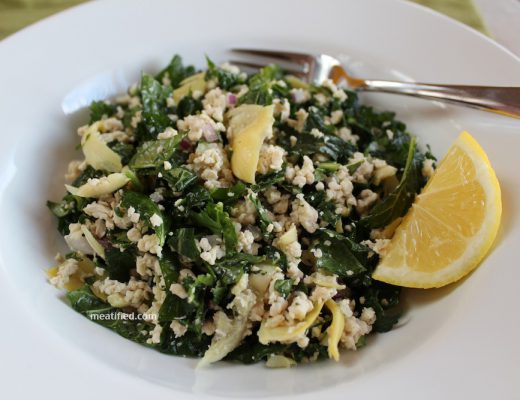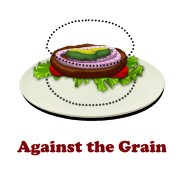We make it clear that we are in no position to expertly and thoroughly explain the science behind the Paleo Diet. So many people, though, ask us about it. In response, we went out and found a scientist for you. Meet The Paleo Mom, a scientist-turned-at-home-mom. She has written a series of posts for us on the “why” of this way of eating. We hope this will be informative and fun for you. Check out her website, an adorable place full of interesting posts and cute drawings.
Part 1 of 4 in this guest series: What Is A Leaky Gut? (And How Can It Cause So Many Health Issues?)
One of the fundamental principles of paleolithic nutrition is avoiding foods that damage the lining of the gut. Essentially, the gut is just a long, wrinkly tube. Inside this tube, food is digested by enzymes and friendly resident bacteria, breaking down the components of our food to their simplest forms: proteins are broken down into amino acids; carbohydrates are broken down into monosaccharaides; and, fats are broken down into fatty acids. What can’t be digested by our bodies is excreted as waste. Amazingly, a single layer of highly specialized cells (called enterocytes) is all that separates the inside of the tube from the outside. These enterocytes have two very specific jobs: 1) transport the digested nutrients from the “inside-the-gut” side of the cell to the “outside-the-gut” side of the cell; and 2) keep everything else on the inside of the tube. Immediately outside this tube are two important parts of the digestive system: 1) the resident immune cells of the gut whose job it is to protect against pathogens which might accidentally find their way through the enterocytes; and 2) a network of blood vessels and lymphatic vessels that carry the digested nutrients from our food to the tissues in our body that need them (amino acids and monosaccharaides are transported through the blood while fatty acids are transported through the lymphatic system).
A “leaky gut” occurs when either the enterocytes are damaged or the proteins that form the tight bond between these cells and hold them together as a solid layer are damaged (or altered). When this happens, it creates microscopic holes through which some of the contents of the gut can leak out into the blood stream or lymphatic system. What leaks out isn’t big chunks of food. Instead, it’s a combination of many different pathogens: incompletely digested proteins, bacteria or bacterial fragments from those friendly bacteria that are supposed to stay inside your gut, or a variety of toxic substances or waste products that would normally be excreted. When these pathogens leak out, the resident immune cells of the gut recognize them as foreign invaders and mount a response against them (when large quantities of pathogens leak out, other parts of the body, especially the liver, also contribute to the response). Exactly what leaks out, and how much, determines the precise nature of this immune response.
Some pathogenic substances (like bacterial fragments and toxins) cause generalized inflammation by triggering the release of chemicals called inflammatory cytokines (the chemical messengers that circulate in the blood and tell white blood cells to attack). This type of inflammation has no target so any cell in the body can be an innocent victim. It is the liver’s job to both control this type of inflammation and to filter out the toxins that may be triggering it. When the liver is overworked, the toxins build in the body and the inflammation spreads. This type of inflammation can be a major contributor to health issues ranging from psoriasis and asthma to ADHD and depression.
Other substances (like incompletely digested proteins) cause specific inflammation, which can take the form of an allergy or an auto-immune disease. An allergy is caused by immune cells creating IgE-type antibodies targeting a part of a protein that is specific to the food it originated from (like an antibody targeting the casein in milk resulting in a milk allergy). A very similar type of immune response is caused by immune cells creating IgA-, IgM- or IgG-type antibodies targeting a part of a protein that is specific to the food it originated from. This type of immune response is technically considered a food sensitivity (and not an allergy), and can cause both allergy-type symptoms and symptoms that you might not normally attribute to an allergy, such as: pain, fatigue, and eczema. It is also the formation of these types of antibodies that can cause auto-immune diseases. Antibodies target only a short sequence of amino acids, and not all of the amino acids that form an individual protein. In the case of food allergies and sensitivities, this short sequence of amino acids is still specific to the food it originated from. But, sometimes the antibodies that form in response to “leaked-out” proteins target a sequence of amino acids that isn’t unique to that protein, but instead is a sequence of amino acids also found in many other normal proteins in the human body. When this happens, the body attacks itself thinking its own cells are foreign invaders. For example, an antibody could form against a sequence of amino acids that is found in the insulin-secreting beta cells of the pancreas. When the body attacks those cells, it causes Type I Diabetes. An enormous range of autoimmune diseases can be caused in this way, from lupus to celiac disease to Graves’ disease (many of which include genetic susceptibility as confounding factor).
It is important to know that, for some individuals, a leaky gut can develop slowly over years or decades. Stress, sleep-deprivation and/or some infections can make matters worse very quickly (and unpredictably). Once you have a leaky gut, it is only a matter of time before related health conditions begin to crop up. Depending on the extent of the damage to the gut lining, the exact substances that leak out, and your specific genetics, the inflammation and immune reactions caused by having a leaky gut can add up to any of a huge variety of different health conditions, many of which can be life-threatening. This is why the gut-friendly, anti-inflammatory paleo diet is known to address so many different health issues: if your gut is healthy, then so are you.
About The Paleo Mom: Sarah Ballantyne is a scientist turned stay-at-home mom and a recent convert to paleolithic nutrition who is working hard to address her own health issues and to improve her family’s nutrition and health. She blogs about her own experimentation with different implementations of the paleo diet, about her efforts to transition her family to paleolithic nutrition, and shares her successful recipes. Sarah’s passion is to share her biology, physiology and nutrition knowledge through informative posts that distill the science behind the paleo diet into approachable explanations. Visit her site at www.thepaleomom.com or on Facebook or Twitter






